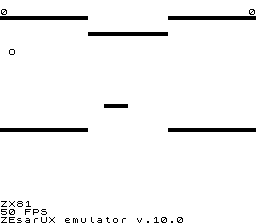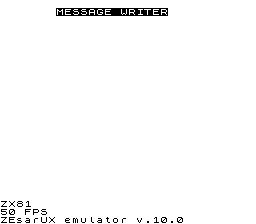Mike Singleton, author of large scale, open-world classics including Midwinter, War in Middle Earth, and our next whale, The Lords of Midnight, is another designer whose name I know through reading articles and histories but whose games I haven't ever played.
This post is about a selection of his early, humbler works, some of which are lost to time. Computer Race, for instance, the first game he programmed after graduating from tinkering on a programmable calculator to a Commodore PET, simulated horse races and featured PETSCII-animations based on Muybridge's famous serial photographs, and sold but a single copy in Ireland, far enough away from the arm of Britain's strict betting laws.
Space Ace
No
relation to Don Bluth's laserdisc followup to Dragon's Lair,
Singleton's Space Ace, c1982, is his earliest game that I can actually
play.
It's Star Fire yet again, and not even the only time a British developer did this
that year. There's one novelty here to make it stand out - try not to
get too excited. You have a "lock on" mechanism that lets you match
speed and vector with a target, and once locked on, the numpad controls
let you hone in on the target. It's not much, but it does slightly
improve the immersion factor, and make the gameplay just a bit more
interesting. But let's not go overboard with the praise - we had Star
Raiders years before.
Presumably you can "beat" the game once you've destroyed eight ships, but I couldn't. The more ships you kill, the more frequently they fire at you. I'm still not clear on exactly how the game determines you get hit, but all too often they'd fire right while I'm aiming right at their centers of mass, which would stunlock me and get me hit by the same bullet repeatedly, often depleting my shields and ending my game.
There's just not enough here for me to analyze, so I have not numbered or rated this game.
Following Space Ace, Singleton snagged a ZX81 computer - a machine which, to be frank, bears more resemblance to a programmable calculator than to the PET that Singleton replaced his with, and quickly tapped out a relative best-seller in time for Christmas.
Game 304: ZX81 Games Pack 1
In two weeks, Singleton programmed six bite-sized, or should I say, kilobyte-sized games, which Sinclair Research distributed on tape.
Our first game is a solo pong variant where you have to bank the ball at an angle to score a point. Without any paddle physics, there's not much you can do to influence the ball's trajectory - just don't miss and you will eventually score a point. But that's okay because you can just position the paddle in the center and win without having to do anything.
Next is a simple racing game where you avoid the edges and dodge obstacles. I don't know if it ends, but I couldn't pass the 999 meter mark.
Third is a Space Invaders clone where I couldn't figure out how to shoot back and didn't care enough to try all that hard.
Fourth isn't even a game, just a silly demo program that displays a message of your choice in the style of an electronic matrix sign.
Fifth is a Breakout clone. This is easily the best game in the pack, but I wouldn't play it twice. Unlike the Pong clone you can affect the ball's path based on whether you hit it with the center of the paddle or not.
Finally, there's a helicopter game where you pick up people and bring them back to the helipad while dodging bullets. It's so easy that a monkey could do it.
GAB rating: Bad. This tape might have sold incredibly well considering the ZX81's market size, but today it does nothing but reinforce my belief that the ZX80/81 were cheap and horrible machines ill-suited for any sort of amusement or educational purpose, and the less often I revisit this system, the happier I'll be.
Mobygames
lists Singleton's next time as "Star Lord," but I believe they are
erroneous in cataloging it as a Commodore PET title, or indeed even as a
video game. It isn't a game you can simply purchase in cassette format
and run on your own PET, nor did it even require owning a computer at
all, but is more akin to a board game played by mail, which Singleton
administrated himself using his PET to compute and print out the results
of each round.
His next few games were Commodore-focused, with compatibility on the newly released ZX81 successor ZX Spectrum being an afterthought.
Game 305: Shadowfax
The first of four games developed in partnership with Postern Ltd., and the first glimpse of Singleton's enthusiasm for Tolkien, Shadowfax reused the horse graphics originally created for Computer Race and saw initial release for Commodore's PET, VIC-20, and the Commodore 64 in 1982, followed by ports to the BBC Micro and later the ZX Spectrum in 1983. The PET version appears to be undumped, giving us no way of seeing singleton's original PETSCII animations.
 |
| VIC-20 version |
 |
| C64 version |
Ride
your white steed like the wind and zap way more than nine black
Nazgûl! It's... not all that exciting, and the gameplay doesn't evolve
past the first few seconds, not even escalating in difficulty, which is
low enough that I'm confident I could last indefinitely if I didn't get
bored and lose focus. You can
only move up and down and shoot, and must release the fire button to
detonate your shot when it touches a ringwraith.
The C64 version animates more smoothly and has trees flanking the playfield, but I prefer the VIC-20 version slightly. Its stark, minimalist look just suits it more, especially the animation that plays when you die. That said, "minimalist" is a terrific descriptor of the gameplay, and I don't mean that in any positive way. Shadowfax wouldn't pass muster as a discount Atari 2600 game.
GAB rating: Bad. It's playable, but I can't see why you'd want to for more than fifteen seconds.
Game 306: Siege
Siege
was released on the same platforms as Shadowfax, but more or less
simultaneously. The BBC Micro version, as with Shadowfax, is co-credited
to Warren Foulkes, and the rest solely to Singleton. All versions are
extant.
 |
| PET version |
These are undoubtedly the best graphics I've ever seen in a PET game, which lacked any kind of graphical ability except for arranging its built-in glyphs and semaphores to approximate visuals, which is what's going on here. No, it won't dethrone Atari, but it does make me wish the PET version of Shadowfax survived.
Inverted Space Invaders of a sort, but much, much easier thanks to the invaders' slow climbing speed and lack of any sort of attack except climbing. You have to be exactly precise with your rocks - only a direct hit to the head counts - and the movement controls are somehow both underresponsive and overresponsive, but the fact that you can bowl over multiple attackers in a single throw like tenpins makes it easy to keep the crowds under control, and it's funny too.
There's once again no difficulty escalation, and it didn't keep me amused for more than a minute or two, but that's already more than I can say about Shadowfax.
I checked out the other Commodore versions as well.
 |
| VIC-20 version |
I
guess these graphics are better, but to me they don't have the charm of
the PET version's crisp monochrome. Maybe it's because I know the
VIC-20 is capable of more than this. It plays pretty much the same, slightly
more difficultly as the soldiers can move side-to-side and the playfield
is wider relative to the sprite sizes, which now only occupy a single
column's width (though they will still knock down adjacent soldiers as
they fall), also giving the impression that the rocks you drop are
man-sized boulders. The PET version also has fanfare at the start of
each round and sound effects for your stone throwing.
 |
| C64 version |
On Commodore 64, the most advanced home gaming platform of the day, Siege is even more underwhelming, and barely distinguishable from the 5KB VIC-20. Same sprites, different colors, bigger playing field. Even the VIC-20 fanfare is missing.
GAB rating: Below average. On any platform it's more fun than Shadowfax, but the meager gameplay and challenge leaves me wanting more. Siege could be a somewhat decent arcade-style game if it were faster paced and had a lot more to do in it - how about some archers that fire back, siege towers and catapults, or maybe a dragon or two? And maybe give me more weapons to juggle threats with, like a crossbow, grapeshot catapults, boiling oil, placeable sentries, etc.
Singleton
would design two more games for Postern; Snake Pit, and the
stereographic 3 Deep Space, but I'm done exploring this era. Next post, I
take on The Lords of Midnight.


















When I saw the topic of the post, I was going to recommend you include his PBM work in your look over his gaming career, but I see now that advice would have fallen on deaf ears 8)
ReplyDeleteI remember Shadowfax! Yeah, it seemed like a real nothing game, but the horse animations were pretty cool.
ReplyDeleteI wonder how much Singleton's later Starlord (1993) is based on the PBM game. It certainly seems like an ambitious effort. Not that I've ever played it but it was so panned by the Finnish game reviewer that it stuck to my mind. (Score: 30/100)
ReplyDelete